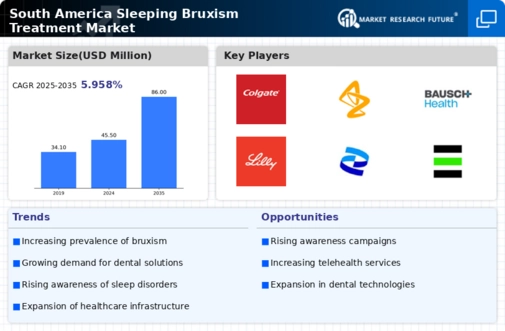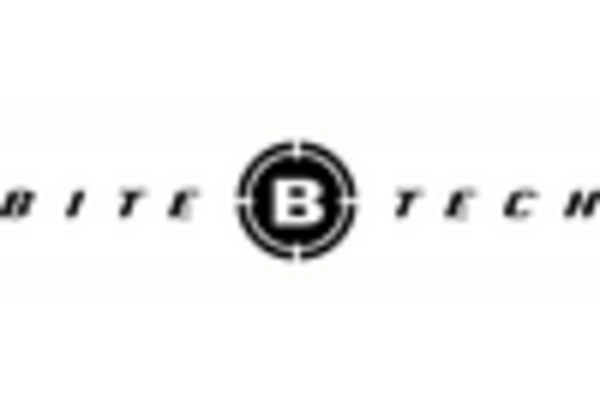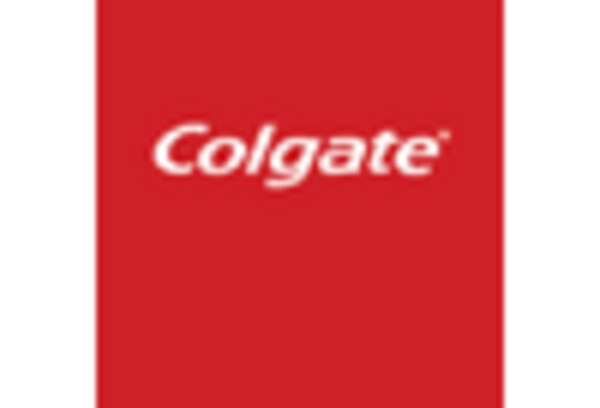Rising Incidence of Sleep Disorders
The increasing prevalence of sleep disorders in South America appears to be a significant driver for the sleeping bruxism-treatment market. Studies indicate that approximately 30% of the population experiences some form of sleep disturbance, which may lead to bruxism. This correlation suggests that as more individuals seek solutions for their sleep issues, the demand for bruxism treatments is likely to rise. The sleeping bruxism-treatment market is thus positioned to benefit from this trend, as healthcare providers and dental professionals become more aware of the connection between sleep disorders and bruxism. Furthermore, the growing recognition of the importance of sleep quality in overall health may lead to increased investments in treatment options, potentially expanding the market further.
Expansion of Dental Care Accessibility
The expansion of dental care accessibility in South America is poised to drive growth in the sleeping bruxism-treatment market. With initiatives aimed at improving healthcare infrastructure and increasing the number of dental professionals, more individuals are gaining access to necessary treatments. This trend is particularly evident in rural areas, where previously limited access to dental care is being addressed. As a result, the sleeping bruxism-treatment market is likely to benefit from a broader patient base seeking treatment for bruxism. Enhanced accessibility may also lead to increased awareness and diagnosis of bruxism, further fueling market growth as more individuals seek effective solutions.
Impact of Stress and Lifestyle Changes
The rising levels of stress and changing lifestyles in South America are contributing to an increase in bruxism cases, thereby impacting the sleeping bruxism-treatment market. Factors such as urbanization, economic pressures, and fast-paced living are leading to heightened anxiety levels, which are known triggers for bruxism. Reports suggest that nearly 25% of adults in urban areas experience bruxism symptoms related to stress. Consequently, the sleeping bruxism-treatment market is likely to see a growing need for treatments that address both the physical and psychological aspects of bruxism. This dual focus may lead to the development of integrated treatment approaches that combine dental care with stress management techniques.
Increased Focus on Preventive Healthcare
There is a notable shift towards preventive healthcare in South America, which is influencing the sleeping bruxism-treatment market. As individuals become more health-conscious, they are increasingly seeking preventive measures to avoid dental issues associated with bruxism. This trend is reflected in the rising sales of dental guards and other preventive devices, which have seen a growth rate of around 15% annually. The sleeping bruxism-treatment market is likely to capitalize on this shift, as consumers prioritize early intervention and preventive strategies. Additionally, educational campaigns aimed at raising awareness about the long-term effects of untreated bruxism may further drive demand for preventive treatments, thereby enhancing market growth.
Growing Demand for Customized Treatment Solutions
The sleeping bruxism-treatment market is experiencing a surge in demand for customized treatment solutions tailored to individual needs. Patients are increasingly seeking personalized approaches, such as custom-fitted mouthguards, which are perceived to be more effective than standard options. This trend is supported by data indicating that customized solutions can reduce bruxism symptoms by up to 40%. The sleeping bruxism-treatment market is responding to this demand by investing in advanced technologies that facilitate the creation of personalized treatment plans. As dental professionals adopt these innovative solutions, the market is likely to expand, catering to the diverse needs of patients across South America.

















Leave a Comment